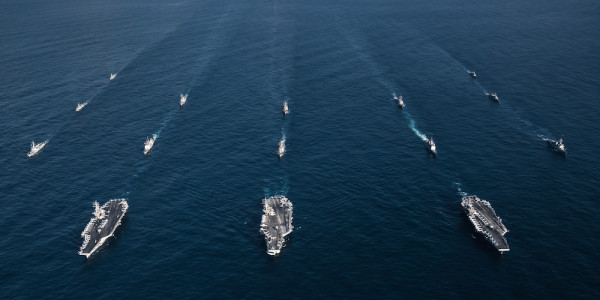

With President Donald Trump wrapping up his “very epic” 12-day visit to Asia amid escalating tensions with North Korea, the Department of Defense has deployed three Navy carrier strike groups for a series of joints exercises in the Western Pacific, the first time three CVNs have linked up for military exercises in the Pacific area of operations since Exercise Valiant Shield back in 2007.
Both Trump’s visit and the three-carrier exercise, which included the massive Japanese helicopter carrier Ise and a fleet of both Japanese and South Korea destroyers, wrapped up on Nov. 14; as the DoD was quick to point out, the joint drills were just the latest carrier exercises conducted in the region, with dual-carrier strike group operations in the South China Sea, East China Sea and the Philippine Sea in recent months.
And while the timing of the exercise, first announced on Oct. 24, seems in keeping with Trump and Kim Jong-Un’s ongoing war of words, the Pentagon has emphasized repeatedly that no, this is just a training exercise, not an overt show of force. “It is a rare opportunity to train with two aircraft carriers together, and even rarer to be able to train with three,” said U.S. Pacific Fleet Commander Adm. Scott Swift said in a Nov. 8 statement. “Multiple carrier strike force operations are very complex, and this exercise in the Western Pacific is a strong testament to the U.S. Pacific Fleet’s unique ability and ironclad commitment to the continued security and stability of the region.”
Uh huh, suuuuuuuure. Given that the Hermit Kingdom’s pissy child god-emperor voids his bowels at the mere mention of the phrase “decapitation strike,” let’s take a look at some glorious, glorious footage of the Navy’s once-in-a-decade flexing up on East Asia’s doorstep.
Precious, right? Here are some photos for your scrapbook:

The aircraft carriers USS Ronald Reagan (CVN 76), USS Theodore Roosevelt (CVN 71) and USS Nimitz (CVN 68) Strike Groups and ships from the Republic of Korea Navy transit the Western Pacific Ocean Nov. 12, 2017. The strike groups conducted operations in international waters as part of a three-carrier strike force exercise.Jared Keller

The aircraft carriers USS Ronald Reagan (CVN 76), USS Theodore Roosevelt (CVN 71) and USS Nimitz (CVN 68) and their strike groups are underway, conducting operations, in international waters as part of a three-carrier strike force exercisePhoto via DoD

The aircraft carriers USS Ronald Reagan (CVN 76), USS Theodore Roosevelt (CVN 71) and USS Nimitz (CVN 68) transit the Western Pacific. The strike groups are underway and conducting operations in international waters as part of a three-carrier strike force exercise.Photo via DoD
Of course, it’s worth noting that this show of force is a double-edged sword, as deploying an excess of over-extended units to a high-tempo area of operation can yield disastrous results. In a Nov. 1 report on the USS Fitzgerald and USS John S. McCain collisions, the Navy acknowledged the silent threat of sleep deprivation and low morale are a major cause of the 7th Fleet’s alarming mishap crisis. The fact of the matter is that the Pentagon budget, despite eclipsing military spending by the likes of Russia and China, “is also spread much more widely,” as Reuters’ Peter Apps wrote of the Navy’s carrier action. “Washington’s military capabilities still dwarf anyone else’s, but it now faces a very real danger that its foes may be able to bleed it to death without ever confronting it in battle.”
Maybe so! But with the U.S. armed forces on the brink of the biggest modernization push since the Vietnam War, perhaps the Navy’s three-carrier ballet in the Pacific sends a very Trumpian message to North Korea: If you can’t handle me at my worst, you don’t deserve me at my best.
We now go live to Kim Jong Un:
